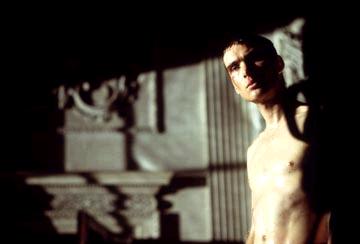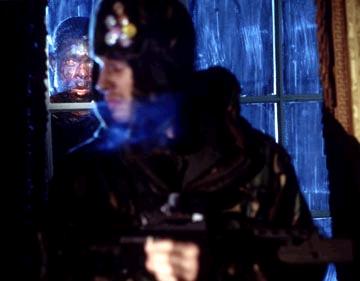

28 Days Later is a horror film. Amazingly, it is not the sequel to the insipid 28 Days, but it is still scary. What makes the film creepy is that it doesn't necessarily rely on blood and gore (although there is some) but roots the story in modern events. Yes, it is a work of fiction, but people can imagine a scenario like this happening. In this world, a virus runs rampant. It turns people into zombies (well, they're technically not dead) who thrash around violently and have no conscious thought except to infect others. In the prologue, animal activists freed some infected primates undergoing bizarre experiments. A scientist warns them, but they don't listen, and they instantly die. The virus them leaps from animal to human, where it quickly reaches epidemic levels.
Director Danny Boyle (The Beach, A Life Less Ordinary) and writer Alex Garland (The Beach) immediately evokes AIDS, and more recently SARS. By grounding the concept of the film with reality, it adds a whole new dimension of horror and realism to the film. Boyle has an eye for the strange (Trainspotting, anybody?), and he works wonders with the stale zombie genre. His zombies do not lumber slowly after people, they hiss, scream, and run. Boyle shows everything through the eyes of Jim (Cillian Murphy, Disco Pigs, How Harry Became A Tree). Jim awakes from a coma twenty-eight days after the disease unleashes itself. He finds himself in a deserted hospital, and wanders the strangely empty streets of London desperately shouting "hello" to anybody who may be listening. It's a truly eerie sight.
He eventually meets Selena (Naomie Harris, Anansi, Living in Hope) and Mark (Noah Huntley, Megiddo: The Omega Code 2, Tom's Midnight Garden), two people who are just trying to survive. They have an extreme Darwinian outlook on the situation. They are looking out for themselves, and if other survivors slow them down, they are just liabilities. Two additional people they later meet, Frank (Brendan Gleeson, Dark Blue, Gangs of New York) and his daughter Hannah (Megan Burns, Liam) serve to counter the views of Selena and Mark. They humanize the situation, showing Jim that there is a reason to fight for the survival of everyone. The events force all the characters to reassess their lives and figure out what they feel is truly important.
Doyle and crew tried to film as early in the day as possible to achieve the empty streets. It's a false sense of serenity, since the infected can come rushing out at them at any moment. Doyle also used digital cameras, which gives them film a grainy look. It actually helps the atmosphere, by making things look blurry, so it can be hard to distinguish what is on the screen. Nevertheless, Doyle begins to succumb near the end of the film. The final sequence is a prolonged action sequence that really stretches the character of Jim from a random bike messenger into some Rambo-like figure. This changes the film into a more conventional narrative that is ultimately less satisfying, but still intriguing.